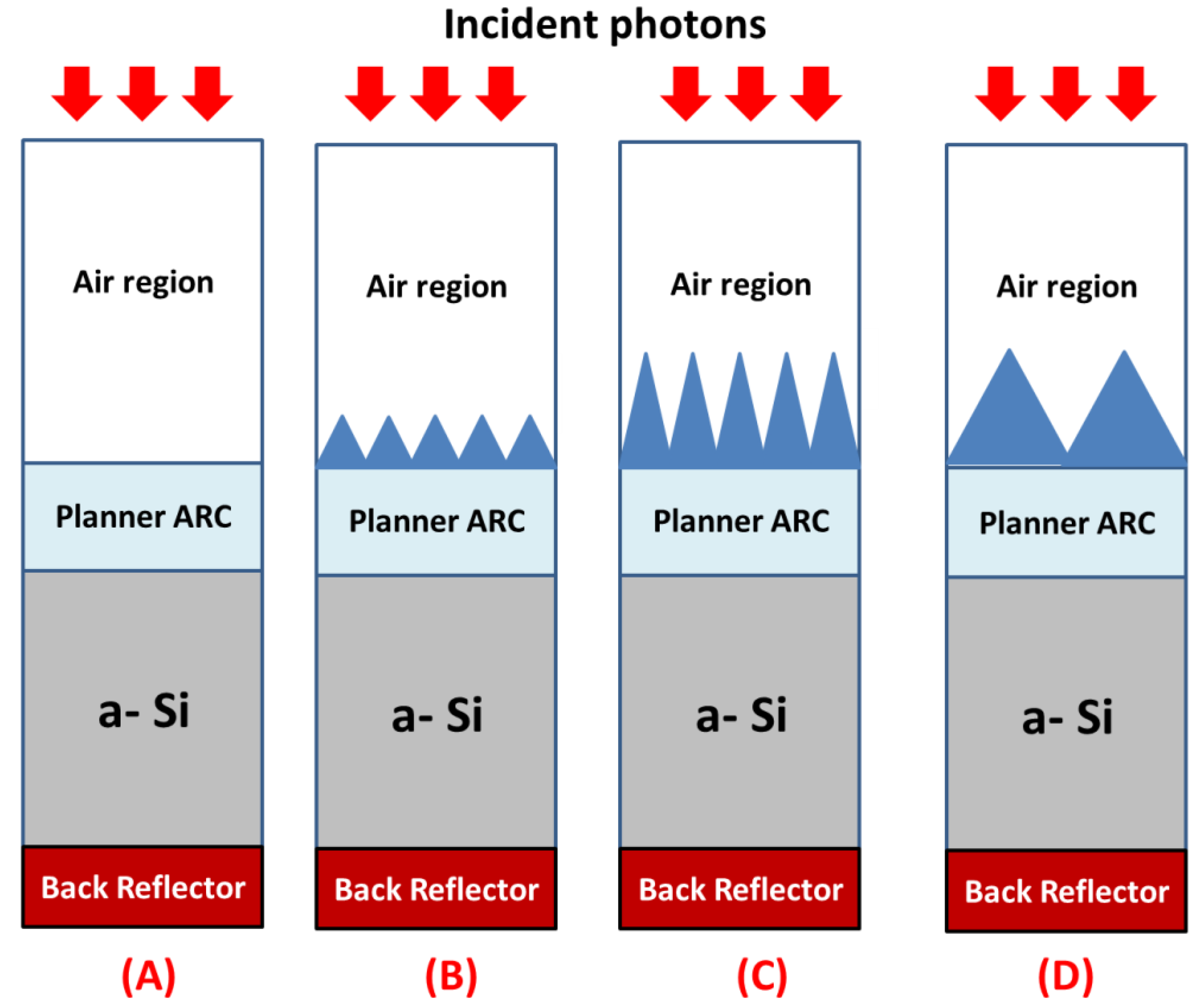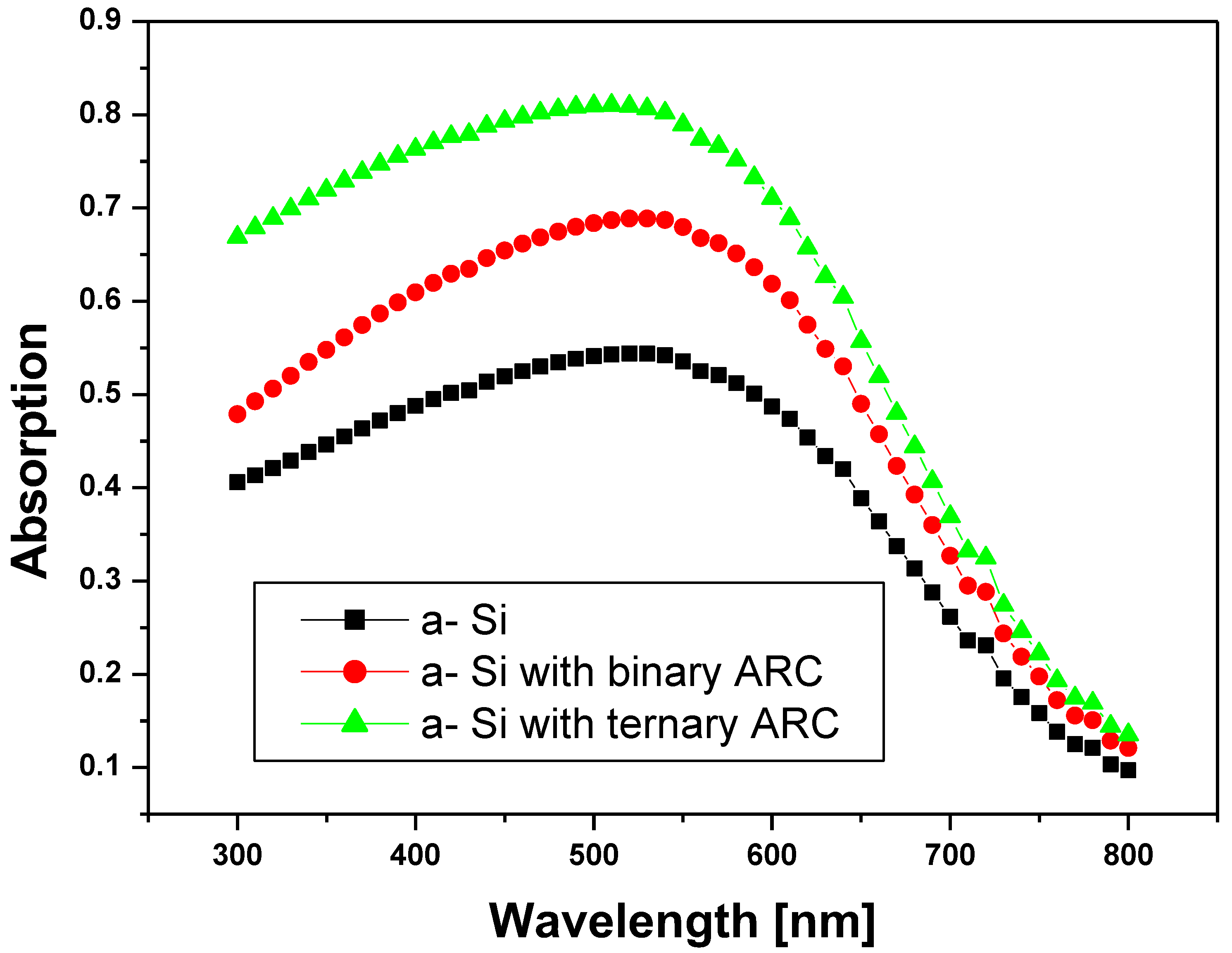Theoretical Analysis of Optical Properties for Amorphous Silicon Solar Cells with Adding Anti-Reflective Coating Photonic Crystals
Abstract
:1. Introduction
2. Modeling and Simulation
3. Results and Discussion
3.1. Anti-Reflection Coating
3.2. Back Reflector
3.3. The Optical Properties of the Cell
4. Conclusions
Author Contributions
Funding
Institutional Review Board Statement
Informed Consent Statement
Data Availability Statement
Acknowledgments
Conflicts of Interest
References
- Alharbi, F.H.; Kais, S. Theoretical limits of photovoltaic efficiency and possible improvements by intuitive approaches learned from photosynthesis and quantum coherence. Renew. Sustain. Energy Rev. 2015, 43, 1073–1089. [Google Scholar] [CrossRef] [Green Version]
- Green, M.A. Crystalline Silicon Solar Cells. In Series on Photoconversion of Solar Energy—Clean Electricity from Photovoltaics; World Scientific: Singapore, 2015. [Google Scholar] [CrossRef] [Green Version]
- Healy, S.A.; Green, M.A. Efficiency enhancements in c-Si solar cells by the incorporation of a region alloyed with germanium. Sol. Energy Mat. Sol. Cells 1992, 28, 273–284. [Google Scholar] [CrossRef]
- Janoch, R.; Wallace, R.; Hanoka, J.I. Commercialization of Silicon Sheet via the String Ribbon Crystal Growth Technique. In Proceedings of the Conference Record of the IEEE Photovoltaic Specialists Conference, Anaheim, CA, USA, 29 September–3 October 1997; IEEE Press: Piscataway, NJ, USA, 1997; pp. 95–98. [Google Scholar]
- Jordan, D.; Nagle, J.P. New generation of high-efficiency solar cells: Development, processing and marketing. Prog. Photovolt. 1994, 2, 171–176. [Google Scholar] [CrossRef]
- Keevers, M.J.; Green, M.A. Efficiency improvements of silicon solar cells by the impurity photovoltaic effect. J. Appl. Phys. 1994, 75, 4022–4033. [Google Scholar] [CrossRef]
- Chowdhury, M.S.; Rahman, K.S.; Chowdhury, T.; Nuthammachot, N.; Techato, K.; Akhtaruzzaman, M.; Tiong, S.K.; Sopian, K.; Amin, N. An overview of solar photovoltaic panels’ end-of-life material recycling. Energy Strategy Rev. 2020, 27, 100431. [Google Scholar] [CrossRef]
- Joannopoulos, J.D.; Johnson, S.G.; Winn, J.N.; Meade, R.D. Photonic Crystals: Molding the Flow of Light; Princeton University Press: Princeton, NJ, USA, 1995. [Google Scholar]
- Sreekanth, K.V.; Zeng, S.; Yong, K.T.; Yu, T. Sensitivity enhanced biosensor using rapheme-based one-dimensional photonic crystal. Sens. Actuators B Chem. 2013, 182, 424–428. [Google Scholar] [CrossRef]
- Aly, A.H.; Mohamed, D. BSCCO/SrTiO3 One Dimensional Superconducting Photonic Crystal for Many Applications. J. Supercond. Nov. Magn. 2015, 28, 1699–1703. [Google Scholar] [CrossRef]
- Qing, X.; Sani, M.H. Optical refractive index sensor for detection of N2, He and CO2 gases based on square resonance nanocavity in 2D photonic crystal. Opt. Commun. 2021, 490, 126940. [Google Scholar] [CrossRef]
- Aly, A.H.; Ryu, S.W.; Hsu, H.T.; Wu, C.J. THz transmittance in one-dimensional superconducting nanomaterial-dielectric superlattice. Mater. Chem. Phys. 2009, 113, 382–384. [Google Scholar] [CrossRef]
- Al-Dossari, M.; Zaky, A.Z.; Matar, Z.S.; Aly, A.H. Effect of geometrical and physical properties of cantor structure for gas sensing applications. Accept. Synth. Met. 2022, 291, 117167. [Google Scholar]
- Yablonovitch, E. Inhibited spontaneous emission in solid-state physics and electronics. Phys. Rev. Lett. 1987, 58, 2059–2062. [Google Scholar] [CrossRef] [PubMed] [Green Version]
- Sayed, H.; Krauss, T.F.; Aly, A.H. Versatile photonic band gap materials for water desalination. Opt.—Int. J. Light Electron Opt. 2020, 219, 165160. [Google Scholar] [CrossRef]
- Sayed, H.; Aly, A.H. Salinity optical sensor by using two-dimensional photonic crystals: Computational study. Mater. Sci. Eng. B 2021, 269, 115169. [Google Scholar] [CrossRef]
- Sayed, H.; Alamri, S.; Matar, Z.; Aly, A.H. Salinity sensor based on 1D photonic crystals by Tamm resonance with different geometrical shapes. Plasmonic 2021, 17, 409–422. [Google Scholar] [CrossRef]
- Aly, A.H.; Sayed, H. Computer simulation and modeling of solar energy based on photonic band gap materials. Opt. Appl. 2018, 48, 117–126. [Google Scholar]
- Aly, A.H.; Sayed, H. Enhancement of the solar cell based on nanophotonic crystals. J. Nanophotonics 2017, 11, 046020-9. [Google Scholar] [CrossRef]
- Aly, A.H.; Sayed, H. Photonic band gap materials and monolayer Solar cell. Surf. Rev. Lett. 2018, 25, 1850103-6. [Google Scholar] [CrossRef]
- Taha, T.A.; Sayed, H.; Aly, A.H.; Elsayed, H.A. Textured concave anti-reflecting coating and convex back reflector to enhance the absorbance of amorphous Si solar cells. Phys. Scr. 2022, 97, 055503. [Google Scholar] [CrossRef]
- Kuang, P.; Eyderman, S.; Hsieh, M.L.; Post, A.; John, S.; Lin, S.Y. Achieving an accurate surface profile of a photonic crystal for near-unity solar absorption in a super thin film architecture. ACS Nano 2016, 10, 616–621. [Google Scholar] [CrossRef]
- Lin, Y.Y.; Xu, Z.; Yu, D.L.; Lu, L.F.; Yin, M.; Tavakoli, M.M.; Chen, X.Y.; Hao, Y.Y.; Fan, Z.Y.; Cui, Y.X.; et al. Dual-layer nanostructured flexible thin-film amorphous silicon solar cells with enhanced light harvesting and photoelectric conversion efficiency. ACS Appl. Mater. Interfaces 2016, 8, 10929–10936. [Google Scholar] [CrossRef]
- Sai, H.; Matsui, T.; Saito, K.; Kondo, M.; Yoshida, I. Photocurrent enhancement in thin film silicon solar cells by combination of anti-reflective sub-wavelength structures and light-trapping textures. Prog. Photovolt. 2015, 23, 1572–1580. [Google Scholar] [CrossRef]
- Sprafke, A.N.; Wehrspohn, R.B. Light trapping concepts for photon management in solar cells. Green 2012, 2, 177–187. [Google Scholar] [CrossRef]
- Anderson, M.J.; Whitcomb, P.J. Design of Experiments. In Kirk-Othmer Encyclopedia of Chemical Technology; John Wiley & Sons Inc.: Hoboken, NJ, USA, 2000. [Google Scholar]
- Yang, L.; Liu, Y.; Wang, Y.; Chena, W.; Chen, Q.; Wu, J.; Kuznetsov, A.; Du, X. 18.87%-efficient inverted pyramid structured silicon solar cell by one-step Cu-assisted texturization technique. Sol. Energy Mater. Sol. Cells 2017, 166, 121–126. [Google Scholar] [CrossRef] [Green Version]
- Barranco, A.; Borras, A.; Gonzalez-Elipe, A.R.; Palmero, A. Perspectives on oblique angle deposition for thin films: From fundamentasl to devices. Prog. Mater. Sci. 2015, 76, 59–153. [Google Scholar] [CrossRef] [Green Version]
- Hawkeye, M.M.; Brett, M.J. Glancing angle deposition: Fabrication, properties, and applications of microand nanostructured thin films. J. Vac. Sci. Technol. A 2007, 25, 1317–1335. [Google Scholar] [CrossRef]
- González-García, L.; Barranco, A.; Páez, A.M.; González-Elipe, A.R.; García-Gutiérrez, M.C.; Hernández, J.J.; Rueda, D.R.; Ezquerra, T.A.; Babonneau, D. Structure of glancing incidence deposited TiO(2) thin films as revealed by grazing incidence small-angle X-ray scattering. Chem. Phys. Chem. 2010, 11, 2205–2208. [Google Scholar] [CrossRef] [PubMed] [Green Version]
- González-García, L.; Colodrero, S.; Míguez, H.; González-Elipe, A.R. Single-step fabrication process of 1-D photonic crystals coupled to nanocolumnar TiO2 layers to improve DSC efficiency. Opt. Express 2015, 23, A1642–A1650. [Google Scholar] [CrossRef]
- Elliot, R.J.; Gibson, A.F. An Introduction to Solid State Physics and Its Application; William Clowes: London, UK, 1974. [Google Scholar]
- Tajik, J.M. Analytical and Numerical Modeling of Organic Photovoltaic Devices. Master’s Thesis, McMaster University, Hamilton, ON, Canada, 2010. [Google Scholar]
- Elsayed, H.A.; Sayed, H.; Taha, T.A.; Alharbi, A.G.; Alenad, A.M.; Alshammari, B.A.; Ahmed, A.M.; Mehaney, A.; Aly, A.H. Simple and efficient design towards a significant improvement of the optical absorption of amorphous silicon solar cell. J. Quant. Spectrosc. Radiat. Transf. 2021, 275, 107890. [Google Scholar] [CrossRef]
- Malitson, I.H. Interspecimen comparison of the refractive index of fused silica. J. Opt. Soc. Am. 1965, 55, 1205–1208. [Google Scholar] [CrossRef]
- Bodurov, I.; Vlaeva, I.; Viraneva, A.; Yovcheva, T.; Sainov, S. Modified design of a laser refractometer. Nanosci. Nanotechnol. 2016, 16, 31–33. [Google Scholar]
- Philip, H.R. Optical properties of silicon nitride. J. Electrochim. Soc. 1973, 120, 295–300. [Google Scholar] [CrossRef]
- Tang, J.F.; Zheng, Q. Applied Film Optics; Shanghai Science and Technology Press: Shanghai, China, 1980. [Google Scholar]
- Ping, L.G.; YiMin, X.; YuGe, H.; Qiang, L. Investigation of one-dimensional Si/SiO2 photonic crystals for thermo photovoltaic filter. Sci. China Ser. E Technol. Sci. 2008, 51, 2031–2039. [Google Scholar]
- Domínguez, S.; García, O.; Ezquer, M.; Rodríguez, M.J.; Lagunas, A.R.; Pérez-Conde, J.; Bravo, J. Optimization of 1D photonic crystals to minimize the reflectance of silicon solar cells. Photonics Nanostruct.—Fundam. Appl. 2012, 10, 46–53. [Google Scholar] [CrossRef]
- Zhu, J.; Yu, Z.; Fan, S.; Cui, Y. Nanostructured photon management for high performance solar cells. Mater. Sci. Eng. R Rep. 2010, 70, 330–340. [Google Scholar] [CrossRef]
- Zaidi, S.H.; Gee, J.M.; Ruby, D.S. Diffraction Grating Structures in Solar Cells. In Proceedings of the Conference Record of the Twenty-Eighth IEEE Photovoltaic Specialists Conference—2000 (Cat. No.00CH37036), Anchorage, AK, USA, 15–22 September 2000; pp. 395–398. [Google Scholar]
- Jahng, W.S.; Francis, A.H.; Moon, H.; Nanos, J.I.; Curtis, M. Is indium tin oxide a suitable electrode in organic solar cells? Photovoltaic properties of interfaces in organic p/n junction photodiodes. Appl. Phys. Lett. 2006, 88, 093504. [Google Scholar] [CrossRef] [Green Version]
- Seo, D.-J.; Shim, J.-P.; Choi, S.-B.; Seo, T.H.; Suh, E.-K.; Lee, D.-S. Efficiency improvement in InGaN-based solar cells by indium tin oxide nano dots covered with ITO films. Opt. Express 2012, 20, A991–A996. [Google Scholar] [CrossRef]
- Jia, J.; Li, Y.; Yao, B.; Ding, Z.; Deng, R.; Jiang, Y.; Sui, Y. Band offsets of Ag2ZnSnSe4/CdS heterojunction: An experimental and first-principles study. J. Appl. Phys. 2017, 121, 215305. [Google Scholar] [CrossRef]













| Anti-Reflection Coating Design | Average Reflectance (%) [400–700 nm] | Reference |
|---|---|---|
| Polished silicon | 35.88 | [18,25] |
| Standard silicon solar cell | 16.23 | [27] |
| Rectangular PC profile | 15.9 | [40] |
| Triangular PC profile | 10.6 | [40,41] |
| Circular PC profile | 17.13 | [40] |
| 1D rectangular PC | 26/14.08 | [42] |
| 1D triangular PC | 7.01/16.62 | [42] |
| 1D ternary PCs | 20.4 | [20] |
| 1D quadrant PCs | 7 | [34] |
| 1D texturing PCs | 5 | Our work |
Publisher’s Note: MDPI stays neutral with regard to jurisdictional claims in published maps and institutional affiliations. |
© 2022 by the authors. Licensee MDPI, Basel, Switzerland. This article is an open access article distributed under the terms and conditions of the Creative Commons Attribution (CC BY) license (https://creativecommons.org/licenses/by/4.0/).
Share and Cite
Sayed, H.; Al-Dossari, M.; Ismail, M.A.; Abd El-Gawaad, N.S.; Aly, A.H. Theoretical Analysis of Optical Properties for Amorphous Silicon Solar Cells with Adding Anti-Reflective Coating Photonic Crystals. Photonics 2022, 9, 813. https://doi.org/10.3390/photonics9110813
Sayed H, Al-Dossari M, Ismail MA, Abd El-Gawaad NS, Aly AH. Theoretical Analysis of Optical Properties for Amorphous Silicon Solar Cells with Adding Anti-Reflective Coating Photonic Crystals. Photonics. 2022; 9(11):813. https://doi.org/10.3390/photonics9110813
Chicago/Turabian StyleSayed, Hassan, Mawaheb Al-Dossari, Mohamed A. Ismail, Nashaat S. Abd El-Gawaad, and Arafa H. Aly. 2022. "Theoretical Analysis of Optical Properties for Amorphous Silicon Solar Cells with Adding Anti-Reflective Coating Photonic Crystals" Photonics 9, no. 11: 813. https://doi.org/10.3390/photonics9110813
APA StyleSayed, H., Al-Dossari, M., Ismail, M. A., Abd El-Gawaad, N. S., & Aly, A. H. (2022). Theoretical Analysis of Optical Properties for Amorphous Silicon Solar Cells with Adding Anti-Reflective Coating Photonic Crystals. Photonics, 9(11), 813. https://doi.org/10.3390/photonics9110813





